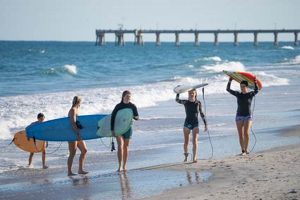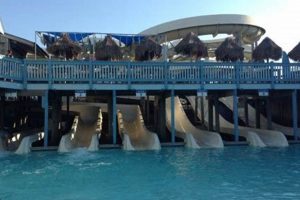The assessment of wave conditions at a specific coastal location provides essential information for surfers, swimmers, and other ocean enthusiasts. Such assessments detail wave height, period, direction, and water temperature, as well as wind speed and direction. This information allows individuals to make informed decisions regarding water activities and safety.
Accessing current and accurate details regarding these ocean conditions is crucial for planning recreational activities and ensuring safety. Historical data allows for the identification of trends and the forecasting of future conditions. The availability of reliable information enables users to optimize their time in the water and minimize potential risks.
This analysis will now explore the typical components of a coastal wave condition summary and provide insight into the factors that influence these conditions. The focus will be on understanding the data provided and its implications for water-based activities.
Interpreting Coastal Wave Condition Data
Understanding the nuances of coastal wave condition data enhances safety and enjoyment of water activities. Adhering to the following guidelines facilitates informed decision-making based on available information.
Tip 1: Wave Height Assessment: Observe the reported wave height, understanding that this is often an average. Larger wave heights necessitate greater caution and may be unsuitable for inexperienced individuals.
Tip 2: Wave Period Evaluation: Longer wave periods generally indicate more powerful waves capable of traveling greater distances. Shorter wave periods may signify choppy conditions.
Tip 3: Wind Direction and Speed Analysis: Onshore winds can create choppy conditions and increase wave size, while offshore winds tend to groom waves, resulting in smoother surf. Strong winds, regardless of direction, can pose a hazard.
Tip 4: Water Temperature Awareness: Knowledge of water temperature is essential for appropriate attire selection. Prolonged exposure to cold water can lead to hypothermia. Utilize appropriate wetsuit thickness based on water temperature.
Tip 5: Tidal Influence Consideration: Tidal fluctuations impact wave breaking patterns and water depth. High tide may reduce wave size, while low tide could expose hazards such as reefs or sandbars.
Tip 6: Rip Current Identification: Be vigilant for rip currents, characterized by discoloration, churning water, or a break in the wave pattern. If caught in a rip current, swim parallel to the shore until free of the current.
Tip 7: Data Source Reliability Verification: Consult multiple sources to corroborate wave condition information. Reliance on a single, potentially inaccurate source can lead to misinformed decisions.
Applying these principles ensures a more informed and safer approach to water-based activities, optimizing both enjoyment and minimizing risk.
The subsequent sections will delve into factors influencing long-term coastal condition predictions and the limitations inherent in forecasting these dynamic environments.
1. Wave Height
Wave height, a primary component of any coastal wave assessment, directly influences the suitability and safety of water-based activities. As a quantifiable measure of the vertical distance between a wave’s crest and trough, it provides critical data for surfers, swimmers, and boaters. For instance, a report indicating wave heights exceeding four feet at Deerfield Beach would signal potentially challenging conditions for novice surfers and necessitate heightened caution for swimmers due to increased undertow and potential for strong currents.
The relationship between wave height and the practicality of a report lies in its predictive capability. Accurate wave height estimations, derived from buoy data, weather forecasts, and historical trends, allow for informed decision-making regarding beach usage. In scenarios where a sustained period of high wave heights is predicted, lifeguards might issue warnings or temporarily close sections of the beach to prevent accidents. Conversely, lower wave heights, as indicated by the report, could attract families and recreational swimmers seeking calmer conditions.
In conclusion, wave height serves as a fundamental metric within a coastal wave assessment, impacting both safety protocols and recreational opportunities. Understanding its value enables stakeholders to mitigate risks and optimize the use of coastal resources. Inaccurate reporting of wave heights, however, can have significant consequences, highlighting the need for reliable data and consistent monitoring.
2. Wave Period
Wave period, an integral component of a coastal wave assessment, reflects the time interval between successive wave crests or troughs. This temporal measurement, expressed in seconds, provides insights into the energy and potential force of incoming waves. Within a report, wave period complements wave height, offering a more complete picture of the surf conditions. A longer wave period typically indicates greater energy and the potential for larger surf, even if the wave height appears moderate. Conversely, a short wave period suggests less energy and choppier conditions. At Deerfield Beach, for example, a wave period of 10 seconds coupled with a wave height of 3 feet signifies a more powerful wave compared to a wave period of 6 seconds with the same wave height. This distinction is crucial for experienced surfers, as it directly influences the type and quality of waves available.
The practical implications of understanding wave period extend beyond surfing. Swimmers and beachgoers benefit from this information when assessing the risk of strong currents and undertow. Longer wave periods often correlate with stronger currents, increasing the risk of being pulled out to sea. Lifeguards utilize this information to determine appropriate safety protocols and alert levels. Furthermore, wave period data is essential for coastal engineers involved in designing and maintaining coastal structures. Understanding the forces exerted by waves with different periods is crucial for ensuring the stability and longevity of seawalls and other protective infrastructure. The analysis of wave period also facilitates the prediction of coastal erosion patterns, enabling proactive measures to mitigate potential damage.
In summary, wave period is a vital parameter within a coastal wave assessment, influencing both recreational activities and coastal management strategies. Its accurate measurement and interpretation enhance safety, inform decision-making, and contribute to the sustainable use of coastal resources. The challenge lies in effectively communicating the significance of wave period to the public, ensuring that beachgoers understand its implications and make informed choices regarding their activities. Further research into wave period dynamics will continue to refine prediction models and improve our understanding of coastal processes.
3. Wind Direction
Wind direction is a crucial component of any coastal wave assessment, significantly impacting wave quality and overall surf conditions. It dictates the formation, size, and shape of waves, directly influencing the experience of surfers and the safety of swimmers. At Deerfield Beach, an onshore wind, blowing from the sea towards the shore, typically generates choppy, disorganized waves unsuitable for surfing. Conversely, an offshore wind, blowing from the land towards the sea, tends to groom waves, creating cleaner, more defined surf with longer rides. The direction of the wind also affects the strength of currents, potentially increasing the risk for swimmers. A report failing to account for wind direction provides an incomplete, and potentially misleading, assessment of coastal conditions.
Practical applications of understanding wind direction are numerous. For surfers, knowing the wind direction allows them to select optimal locations for surfing on a given day. If the prevailing wind is onshore at Deerfield Beach, experienced surfers might seek out a nearby beach offering protection from the wind, resulting in better wave quality. For lifeguards, monitoring wind direction is essential for predicting potential hazards. Onshore winds can rapidly increase wave size and create strong rip currents, necessitating increased vigilance and potential beach closures. Coastal engineers use wind direction data to model wave patterns and predict coastal erosion, aiding in the design of effective coastal protection measures. Accurate measurement of wind direction, therefore, is vital for informing decision-making across various sectors, from recreational activities to coastal management.
In summary, wind direction is an indispensable element of a comprehensive coastal wave assessment. Its influence on wave quality, current strength, and overall safety cannot be overstated. Neglecting wind direction in a report leads to an inaccurate representation of coastal conditions and potentially compromises the safety of beachgoers. Continuous monitoring of wind direction, coupled with accurate reporting, is essential for ensuring the responsible and sustainable use of coastal resources. Future advancements in weather forecasting technology will further refine wind direction predictions, enhancing the accuracy and reliability of assessments.
4. Water Temperature
Water temperature is a critical component of any comprehensive coastal wave assessment, directly impacting the safety and comfort of individuals engaging in water activities. It represents a quantifiable measure of the thermal energy present in the water, typically expressed in degrees Fahrenheit or Celsius. In the context of Deerfield Beach, water temperature fluctuations throughout the year significantly influence the types of activities undertaken and the necessary protective gear required. For instance, during the summer months, the water temperature often rises above 80F, necessitating little to no thermal protection for swimmers and surfers. Conversely, in the winter months, water temperatures can drop below 70F, requiring the use of wetsuits to prevent hypothermia. This seasonal variation underscores the importance of incorporating accurate water temperature data into any analysis of coastal conditions.
The practical significance of monitoring water temperature extends beyond personal comfort. Water temperature plays a role in marine ecosystems, influencing the distribution and behavior of marine life. Changes in water temperature can affect the prevalence of certain species, including harmful algae blooms, impacting both recreational activities and the local economy. A comprehensive assessment, therefore, should consider not only the current water temperature but also historical trends and potential impacts on the marine environment. Furthermore, water temperature data is used in conjunction with other parameters, such as wind direction and wave height, to predict the likelihood of rip currents and other hazardous conditions. Lifeguards utilize this information to make informed decisions regarding beach closures and swimmer safety protocols.
In summary, water temperature is an essential element of a reliable assessment, influencing both human activities and the health of the marine environment. Its accurate measurement and reporting are crucial for promoting safety, informing resource management decisions, and ensuring the sustainability of coastal ecosystems. The challenge lies in consistently monitoring water temperature and integrating this data effectively into assessments accessible to the public. Future advancements in sensor technology and data analysis will enhance the precision and accessibility of water temperature information, further improving the value of a detailed assessment.
5. Tidal Information
Tidal information is an indispensable component of a detailed coastal wave assessment. The rhythmic rise and fall of sea levels, governed by gravitational forces, significantly alters wave dynamics, impacting both surf conditions and navigational safety. The magnitude and timing of tides influence wave height, wave period, and the presence of currents. At Deerfield Beach, the stage of the tide directly modifies water depth over sandbars and reefs, thereby altering wave breaking patterns. High tide may reduce wave size and intensity, while low tide can expose submerged hazards and create stronger currents. Therefore, integrating precise tidal predictions into a comprehensive evaluation is paramount for accurate interpretation.
Practical applications of considering tidal influence are wide-ranging. Surfers rely on knowledge of tidal stages to predict optimal surfing conditions. Certain breaks may only function effectively during specific tidal windows, when water depth and current flow align favorably. Swimmers must be aware of tidal currents, which can increase significantly during tidal shifts, potentially creating hazardous conditions. Lifeguards utilize tidal information to anticipate changes in wave behavior and adjust beach safety protocols accordingly. Furthermore, tidal data is crucial for navigation, particularly in areas with shallow channels or nearshore reefs. Accurate tidal predictions prevent groundings and ensure safe passage for vessels. Real-time tidal information, coupled with wave data, enables informed decision-making for all users of the coastal environment.
In summary, tidal information is not merely an ancillary detail, but rather an essential element in a complete wave assessment. Its influence on wave dynamics, current patterns, and navigational safety is substantial. Neglecting tidal information in a wave analysis leads to an incomplete and potentially misleading understanding of coastal conditions. Challenges remain in providing easily accessible and readily interpretable tidal data to the public. However, ongoing advancements in tidal modeling and dissemination technologies continue to improve the accuracy and usability of this information, ultimately enhancing the safety and enjoyment of coastal activities.
Frequently Asked Questions Regarding Deerfield Beach Wave Conditions
The following questions address common inquiries concerning wave conditions, providing clarity on interpretation and practical applications.
Question 1: What constitutes a reliable source for wave information?
A reliable source incorporates data from multiple buoys, weather models, and local observations. Cross-referencing information across various platforms enhances accuracy and reduces reliance on potentially flawed individual reports.
Question 2: How frequently are assessments updated?
Update frequency varies depending on the source. Real-time buoy data updates frequently, whereas forecasts may be updated several times daily. Consulting the update timestamps is crucial for assessing data currency.
Question 3: What is the significance of swell direction in evaluating wave conditions?
Swell direction dictates the angle at which waves approach the shoreline. Swells arriving perpendicular to the shore typically produce more consistent and predictable surf, while angled swells may result in uneven wave distribution and increased current activity.
Question 4: How does rainfall affect wave quality?
Rainfall can diminish water clarity and introduce debris, potentially compromising the surfing experience and posing health risks. Furthermore, heavy rainfall can alter salinity levels near river mouths, impacting local currents.
Question 5: What factors contribute to localized variations in conditions along the coastline?
Bathymetry, coastal orientation, and the presence of structures such as jetties or piers influence wave refraction and diffraction, leading to localized variations in wave height and direction. Awareness of these factors aids in selecting optimal locations based on specific preferences.
Question 6: How can one assess rip current risk using wave data?
Rip currents are more prevalent during periods of high wave energy and significant tidal fluctuations. Observing breaks in wave patterns, discolored water, or debris moving seaward are indicators of potential rip current activity. Vigilance and adherence to lifeguard warnings are essential.
A comprehensive understanding of these frequently asked questions facilitates informed decision-making and promotes safer enjoyment of coastal resources.
The subsequent section will explore advanced techniques for predicting nearshore oceanographic events and their implications for water safety.
Conclusion
This exploration of the “deerfield beach surf report” underscored its multifaceted nature, emphasizing the interplay of wave height, wave period, wind direction, water temperature, and tidal information. Each element contributes uniquely to the overall assessment, influencing both recreational opportunities and potential hazards. A comprehensive understanding of these components is crucial for informed decision-making regarding water-based activities.
The accuracy and reliability of such coastal wave condition assessments are paramount for ensuring safety and promoting responsible use of coastal resources. Continuous advancements in data collection and predictive modeling will further refine the utility of these reports, enabling more effective risk management and informed enjoyment of the marine environment. It is imperative to consult reliable sources and heed local warnings to prioritize safety and preserve the integrity of coastal ecosystems.







